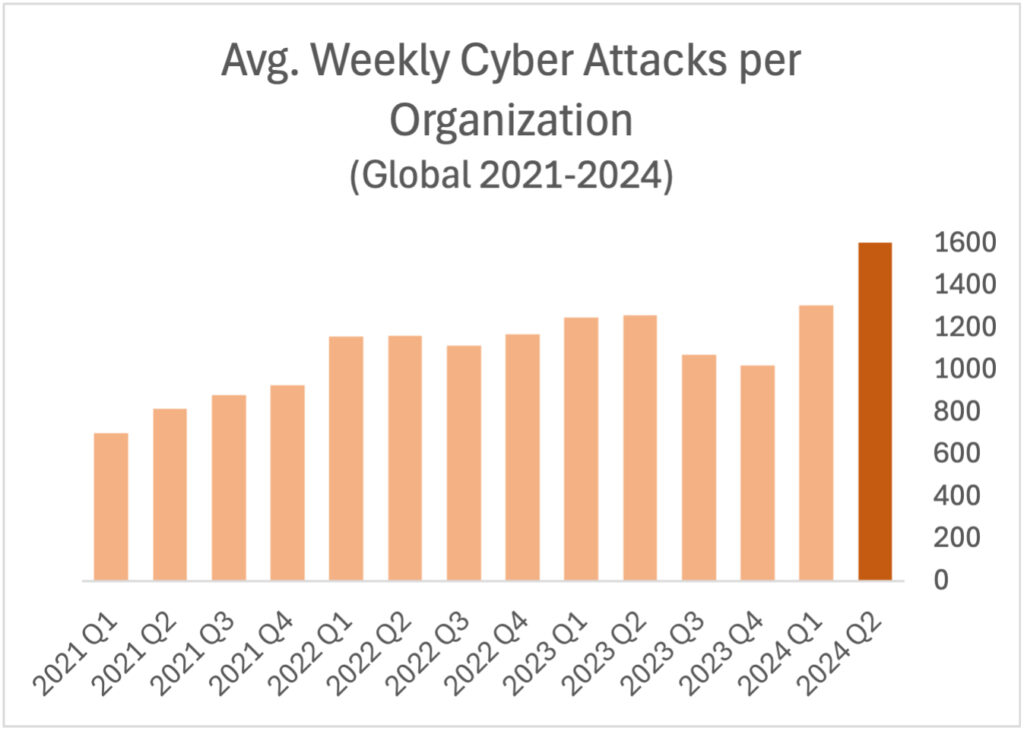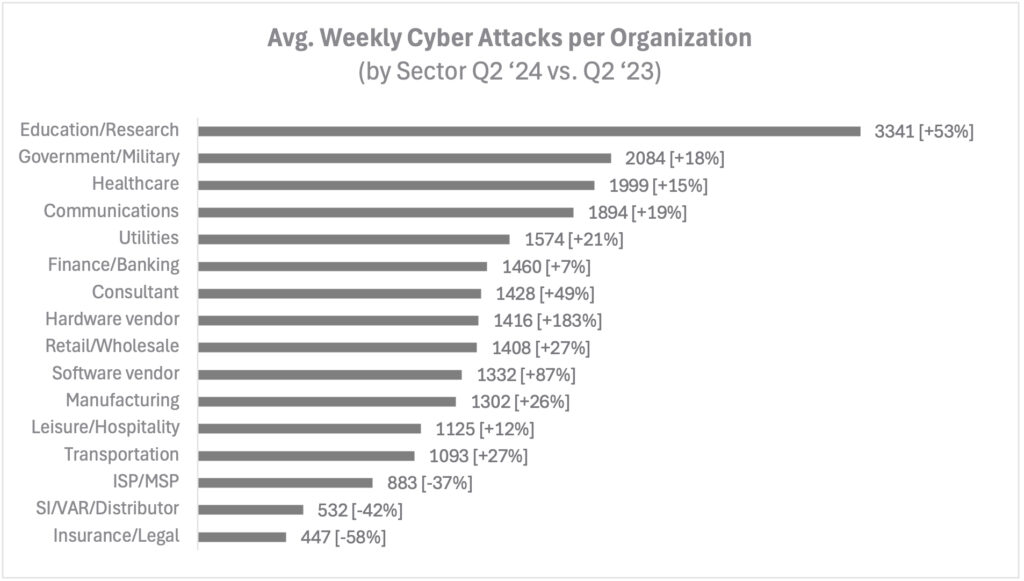Check Point® Software Technologies Ltd. (NASDAQ: CHKP), a leading AI-powered, cloud-delivered cyber security platform provider, released new data on Q2 2024 cyber-attack trends, segmented by global volume, industry, and geography. The rise in cyber-attacks is driven by increasing digital transformation and sophisticated cybercriminal techniques, including AI and machine learning.
Regionally, Africa experienced the highest average weekly cyber-attacks per organisation in Q2 2024, with an average of 2,960 attacks, marking a 37% increase compared to the same period in 2023. Latin America saw the most significant rise, with attacks increasing by 53% year-over-year to an average of 2,667 per week. The Asia-Pacific (APAC) region followed with a 23% increase, highlighting the global spread of cyber threats.
Key Africa Statistics
Highest Average Weekly Cyber Attacks: Africa experienced the highest average weekly cyber-attacks per organisation in Q2 2024, with an average of 2,960 attacks, marking a 37% increase compared to the same period in 2023.
Drop in Ransomware Attacks: Africa accounted for 1% of all reported ransomware attacks in Q2 2024, showing a 55% decrease from the previous year.
Top Attacked Countries: South Africa, Kenya, and Nigeria are among the top African countries facing significant cyber threats, with South Africa experiencing an average of 1,450 weekly attacks per organisation, marking a 4% YoY increase.
Prevalent Malware Types: Qbot and FakeUpdates (SocGholish) are among the most prevalent malware types affecting African organizations, with significant impacts in South Africa.
Key Global Statistics
- Global Increase: In Q2 2024, Check Point Research recorded a 30% year-over-year (YoY) increase in cyber-attacks globally, with organisations facing an average of 1,636 attacks per week.
- Most Attacked Industries: Education/Research (3,341 attacks per week), Government/Military (2,084 attacks per week), and Healthcare (1,999 attacks per week) were the top three most attacked industries.
- Regional Impact: Latin America (+53%), Africa (+37%), and Europe (+35%) experienced the largest YoY increases in cyber attacks. Africa had the highest volume of attacks, averaging 2,960 weekly attacks per organisation.
Ransomware Attacks
Ransomware attacks involving public extortion increased by 13% YoY, totalling approximately 1,200 incidents globally in Q2 2024. North America was the hardest hit, accounting for 58% of all reported ransomware attacks. Africa, although only comprising 1% of these attacks, still shows a significant need for improved cybersecurity defences.
Industry Impact
The Manufacturing sector was the most affected, representing 29% of publicly extorted ransomware attacks’ victims globally, with a 56% YoY increase. Healthcare followed, accounting for 11% of the attacks, with a 27% increase. The Communications and Utilities sectors experienced dramatic rises in ransomware incidents, with increases of 177% and 186% respectively.
Prevention and Mitigation Strategies
To safeguard against these rising threats, organisations must adopt comprehensive cybersecurity strategies:
- Enhance Security Posture: Regularly update and patch systems, and implement multi-layered security measures including firewalls and endpoint protection.
- Employee Training and Awareness: Conduct regular training sessions to educate employees about the latest cyber threats and phishing tactics.
- Advanced Threat Prevention: Use technologies such as sandboxing and anti-ransomware tools to detect and block sophisticated attacks.
- Zero Trust Architecture: Implement strict identity verification for every person and device attempting to access network resources.
- Regular Backups and Incident Response Planning: Ensure regular backups of critical data and develop comprehensive incident response plans.
- Network Segmentation: Isolate critical systems to limit the spread of attacks and protect sensitive information.
- Vulnerability Management: Conduct regular vulnerability assessments and penetration testing, prioritising remediation efforts based on potential impact.
The dramatic rise in cyber-attacks globally, particularly ransomware incidents, signals an urgent need for robust cybersecurity frameworks. Organisations must prioritise cybersecurity, adopting customized strategies to effectively combat the evolving threat landscape. By implementing advanced security measures, fostering a culture of awareness, and preparing for potential incidents, businesses can better defend against the relentless tide of cyber threats.




